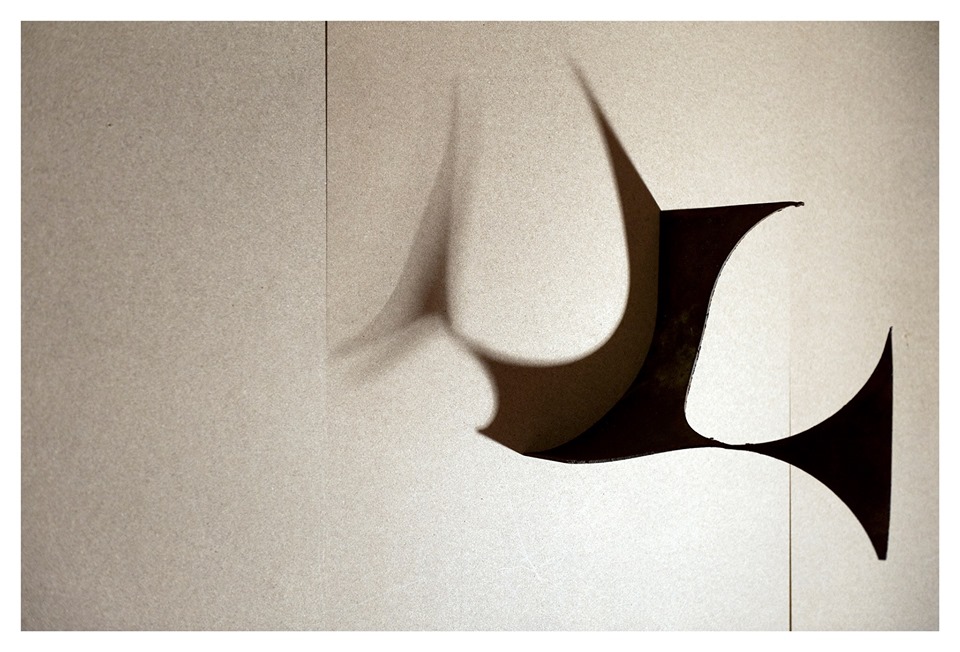For the 4th series of Accrochage exhibitions at ProjecteSD we are pleased to introduce the work of young artist Oriol Aribau brought together with works by Patricia Dauder, Ana Jotta and Asier Mendizabal, never shown in Barcelona before.
Oriol Aribau’s (Barcelona, 1984) work develops mainly through works on paper and sculptures, and it has as a main source architecture and urbanism. His medium, his main tool is the city, the built space, highly accessible, with which he interacts daily. The series of drawings presented at ProjecteSD emerge from the artits’s everyday experience in relationship to this immediate physical environment. They result from records, notations of his wanderings, his walks around urban spaces. Through a geometry of clustered, sometimes scattered, almost ingravid polygonal figures in a nearly empty space, Aribau portrays a fragmentary vision of a city. It can be somethimg as brief as his immediate spatial perception inside a train station in a yet not walked city, or a larger, more detailed landscape after a longer experience, a longer displacement. Or just a short vanishing trace of himself as a passer-by en route. Drawings that seek to activate an awareness of being, moving in space, in time. They can be read as notes, maps, plans, incomplete diagrams, details, but most of all they are a sinthetic depiction of existing spaces that become imaginary spaces. Only a segment of something bigger that reveals itself in glimpses and that it is still to be discovered.
Patricia Dauder’s work (Barcelona, 1973), essentially abstract and procedural, presents records, tears, discolorations, marks and layers that compose, accumulate and constitute a new body. The will to see beyond the immediate visible surrounding world conducts her research. She attempts to capture what is extremely difficult to retain: time, a fleeting moment, an ephemeral trajectory, something with no form, a remote place or a mental projection. Model #6 (Elliptical system. Day and Night) belongs to a series of sculptural works where a number of modular forms are laid out horizontally on bases or directly on the ground. In all these works the relationship between form and void, negative and positive spaces is evidenced. In Model #6 (Elliptical system. Day and Night) a few semi-spherical fragments made in pigmented clay are arranged in a sort of elliptical course. The so called “model” does not relate to any specific architectural project but to a mental projection of a site defined by absence and presence and evocative of a circular movement and the cyclic nature of time.
Known for her cutting irony and criticism about the concepts of authorship or originality, extraordinarily diverse and heteroclite in her conception, formulation or presentation, Ana Jotta’s work (Lisboa, 1946), occupies a space of freedom, using techniques as varied as painting, collage, drawing, “assemblage”, sculpture, sound, embroidery, engraving, writing or appropriation of objects from various sources. The Ricochete series are the result of applying the sum of various engraving techniques on identical pre-existing paper objects: unused gun shooting targets acquired by Jotta at a second hand fair in Brussels. The forms engraved into these backgrounds are made using woodcuts, by pressing color-inked wooden blocks, in this case pieces from a children’s game also acquired by the artist at an antiques fair, onto paper. Overlapping these almost circular forms, there are others resulting from “chine-collé”, the bonding of Japanese paper onto another surface. In an inevitable relationship with the practises and forms stemming from the first Modernist manifestations of the early 20th century (namely those of the Constructivists and the first experiments by the Abstract artists), the whole results in a kind of ongoing, playful composition.
Over the years, Asier Mendizabal (Ordizia, 1973) has completed a number of works that propose a critical approach to the legacy of Jorge Oteiza and the way of constructing the symbolism of his sculptural project. Agoramaquia (Version nº1) is one of the five sculptures that compose Agoramaquia (The Exact Case of the Statue), Mendizabal’s project for the 31st São Paulo biennial (2014). The work takes as its starting point the monument Homage to César Vallejo, which Oteiza made in Lima in 1961. Oteiza’s funerary stela to Vallejo was made by folding two cylindrical steel sheets from which two circles had been cut out. Mendizabal’s research lead him to conclude that these sheets could have been, in reality, the enlarged remaining cut-out parts of one of the most paradigmatic works by Oteiza, the Par Móvil (Mobile Pair). Thus in Agoramaquia Mendizabal replicated the two steel cut-outs at the scale of the Lima monument to build five sculptures made of rubber and iron, malleable so that can be folded to result in different sculptural forms according to the different combinations of the two main elements in space. Very much connected conceptually to this sculpture, the photo series, Incurvar, focuses on the real remains of works by Oteiza, fragments of mainly sculptural pieces and parts that bear witness to the residual and incomplete, apparently condemned to never embody the symbolic potential of the work of art.
